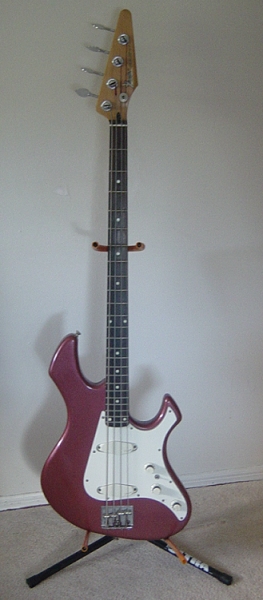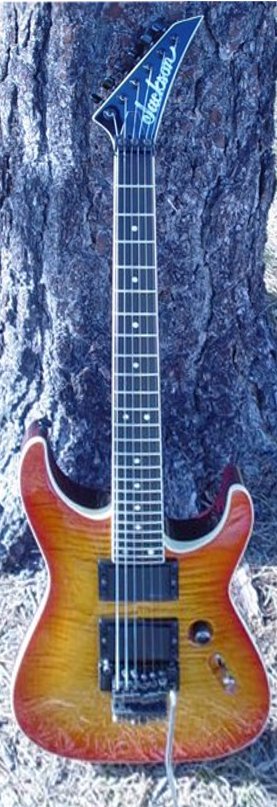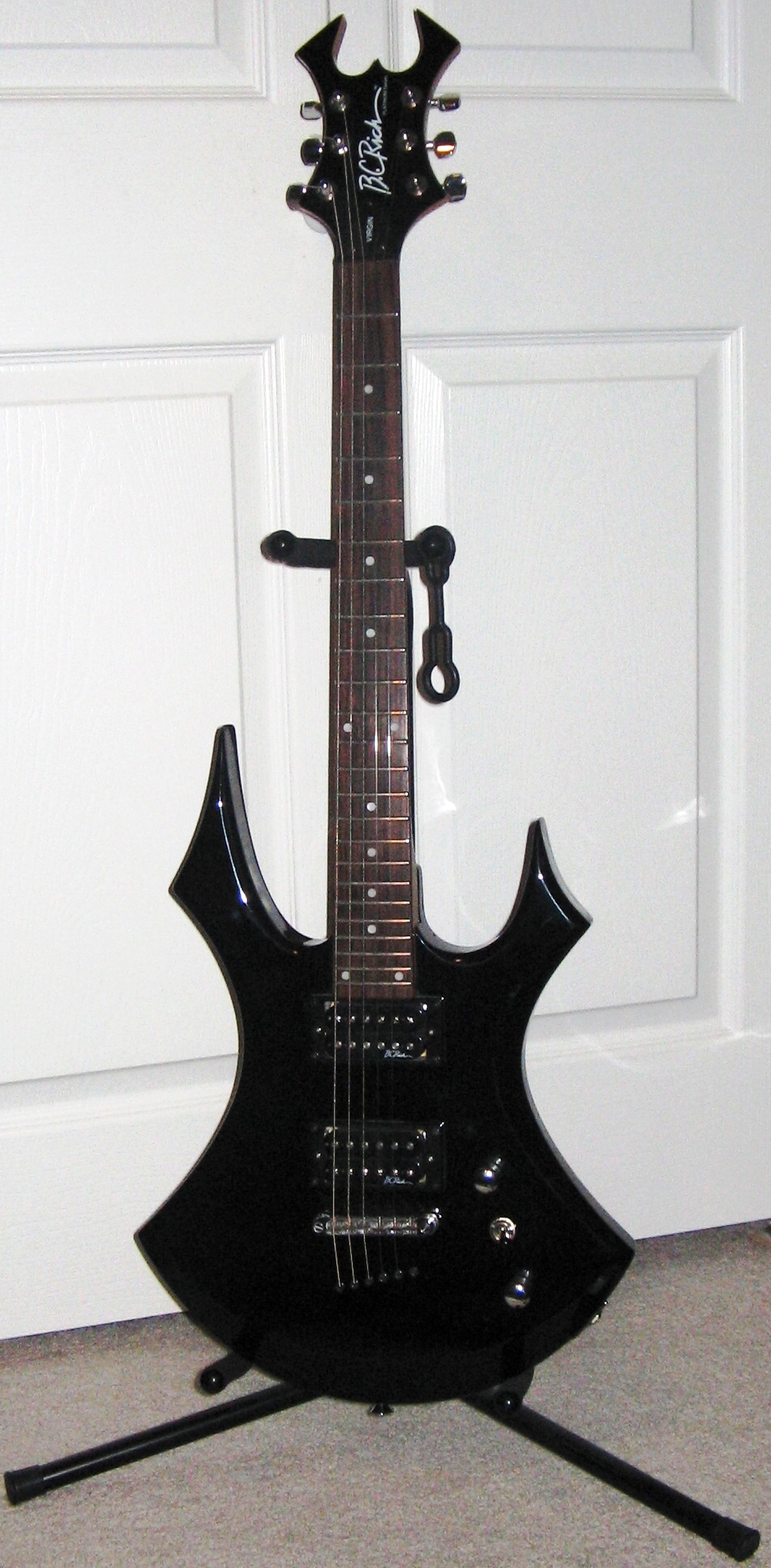|
Fender Performer Bass
The Fender Performer was an electric bass guitar released in 1985 and discontinued in 1987, assembled in the United States and Japan. A Fender Performer electric guitar was also available. Description The Fender Performer Bass was a uniquely styled bass guitar, designed by John Page, and renowned for its extremely slender neck (narrower than Stratocaster and Telecaster guitars). The Japanese Performer Standard has an alder body, with a bolt-on 34" 24-fret micro-tilt adjustable maple neck and a 2-octave rosewood fingerboard, as opposed to the United States-made Performer Elite, which sports an ebony fretboard. Controls are: Volume, Pickup Selector Switch and TBX Circuit Control (Treble Bass eXpander). The latter provided the same tonal range as the Jazz Bass between 0 and 5, with the range 5-10 providing significantly brighter sound – oriented towards solo playing and particularly suiting the sharp attack needed for a slap bass playing style. Both basses were available in Bur ... [...More Info...] [...Related Items...] OR: [Wikipedia] [Google] [Baidu] |
Fender Performer
The Fender Performer was an electric guitar designed by John Page for rock and metal guitarists in the mid-1980s. The Performer was also available as an electric bass. Origins The Performer was first introduced in 1985, and was assembled by Fender Japan, Ltd. It was introduced in the transition from the CBS-owned Fender Electric Instrument Manufacturing Company to the new privately owned Fender Musical Instruments Corporation, from www.fender.com and it was discontinued after only one year. The Performer was commissioned to combat lost sales to the " Superstrats" that were flooding the market in the mid-’80s. Features The body is small with a deep double cutaway similar to the |
Slap Bass
Slapping and popping are ways to produce percussive sounds on a stringed instrument. It is primarily used on the double bass or bass guitar. Slapping on bass guitar involves using the edge of one's knuckle, where it is particularly bony, to quickly strike the string against the fretboard. On bass guitars, this is commonly done with the thumb, while on double bass, the edge of the hand or index finger may be used. Popping refers to pulling the string away from the fretboard and quickly releasing it so it snaps back against the fretboard. On bass guitar, the two techniques are commonly used together in alternation, though either may be used separately. Overview On the double bass, the technique was developed by jazz bands in New Orleans in the early 1900s, and later spread to other genres, including western swing, rockabilly, and other offshoots of those styles. On the bass guitar, the technique is widely credited to Larry Graham, an electric bassist playing with Sly and the F ... [...More Info...] [...Related Items...] OR: [Wikipedia] [Google] [Baidu] |
Wayback Machine
The Wayback Machine is a digital archive of the World Wide Web founded by the Internet Archive, a nonprofit based in San Francisco, California. Created in 1996 and launched to the public in 2001, it allows the user to go "back in time" and see how websites looked in the past. Its founders, Brewster Kahle and Bruce Gilliat, developed the Wayback Machine to provide "universal access to all knowledge" by preserving archived copies of defunct web pages. Launched on May 10, 1996, the Wayback Machine had more than 38.2 million records at the end of 2009. , the Wayback Machine had saved more than 760 billion web pages. More than 350 million web pages are added daily. History The Wayback Machine began archiving cached web pages in 1996. One of the earliest known pages was saved on May 10, 1996, at 2:08p.m. Internet Archive founders Brewster Kahle and Bruce Gilliat launched the Wayback Machine in San Francisco, California, in October 2001, primarily to address the problem of web co ... [...More Info...] [...Related Items...] OR: [Wikipedia] [Google] [Baidu] |
Peavey Electronics
Peavey Electronics Corporation is an American company that designs, develops, manufactures and markets professional audio equipment. One of the largest audio equipment manufacturers in the world, it is headquartered in Meridian, Mississippi. History Hartley Peavey founded Peavey Electronics in 1965, having built his first amplifier in 1957. Peavey Electronics is privately owned. In 2011, ''Inc.'' magazine profiled the global success story of music and audio innovator Hartley Peavey and Peavey Electronics Corporation. "Hartley Peavey dreamed of becoming a rock star," wrote ''Inc.''s Kasey Wehrum. "Though he lacked the chops to become the next Chuck Berry, his name has been etched into the pantheon of rock 'n' roll history." Company information Peavey currently owns of manufacturing/assembly area over 33 facilities across North America, Europe and Asia, 18 of which are located in Mississippi. Products are manufactured mainly in China and the United States, and are distributed ... [...More Info...] [...Related Items...] OR: [Wikipedia] [Google] [Baidu] |
Jackson Guitars
Jackson is a manufacturer of electric guitars and electric bass guitars that bears the name of its founder, Grover Jackson. The company was acquired by the Fender Musical Instruments Corporation in 2002, which manufactures Jackson-branded guitars in its Corona, California, US and Ensenada, Mexico facilities. Low-priced "budget" models are produced by sub-contractors in Indonesia and China. History Early years Grover Jackson obtained part ownership in Charvel's Guitar Repair of Glendora, California in the 1970s. Wayne Charvel eventually filed bankruptcy and sold his interest to Grover Jackson on November 10, 1978, which gave Jackson control of the Charvel name. Jackson Guitars originated in 1980 when guitarist Randy Rhoads approached the company with an idea for an individualized guitar. The collaborative design effort between Rhoads, Grover Jackson, Tim Wilson, and Jackson's masterbuilder, Mike Shannon, resulted in the creation of the ''Concorde'', an innovative revamp of th ... [...More Info...] [...Related Items...] OR: [Wikipedia] [Google] [Baidu] |
Bc Rich
B.C. Rich is an American brand of acoustic and electric guitars and bass guitars founded by Bernardo Chavez Rico in 1969. History The company started making electric guitars in the 1970s. In the following decade B.C. Rich gained a broad exposure with the popularity of heavy metal and has often been linked to that music scene. High-end B.C. Rich instruments were custom-made in the US by Ron Estrada whereas the mid- and low-end models were produced in different countries in Asia. The company briefly switched owners in the 1990s before being acquired in the 2000s by Hanser Music Group, a distribution company based in Hebron, Kentucky. B.C Rich was later licensed to Praxis Musical based in Orange, California until 2018. On July 21, 2019, the official B.C. Rich Facebook page announced a change in ownership. The new management has reintroduced BC legacy models such as the IronBird and Stealth. Design and types Initially the pickups were Gibson, rewired as four-conductor and pott ... [...More Info...] [...Related Items...] OR: [Wikipedia] [Google] [Baidu] |
Kramer Guitars
Kramer Guitars is an American manufacturer of electric guitars and basses. Kramer produced aluminum-necked electric guitars and basses in the 1970s and wooden-necked guitars catering to hard rock and heavy metal musicians in the 1980s; Kramer is currently a division of Gibson Guitar Corporation. Formation There is some dispute over the company's early history but it begins with Travis Bean, a California luthier who was building guitars with aluminum necks. Bean and Gary Kramer started the Travis Bean guitar company in 1974, in Sun Valley, and while their guitars did well, Bean lost interest and left most of the business aspects to Kramer and so the two parted ways. Kramer then founded the company that still bears his name, improving on the Bean design—Bean's necks were heavy and the material felt cold to the touch. Kramer's improvement consisted of two wooden inserts in the back of the neck. By 1975 he had hooked up with a friend from New York, Dennis Berardi and the two f ... [...More Info...] [...Related Items...] OR: [Wikipedia] [Google] [Baidu] |
Bill Schultz (Fender)
William Charles Schultz (July 30, 1926 – September 21, 2006) was the CEO of Fender Musical Instruments Corporation, and is credited as the "man who saved Fender." Biography Born at McKeesport, Pennsylvania, Schultz graduated as an engineer from the New Jersey Institute of Technology in 1965 and went to work for Bethlehem Steel, Baltimore. While working at Bendix Aerospace on radar tracking devices for the Apollo program, he got a master's in aerospace engineering. In 1971 he received an MBA from Rutgers University and got a job at CBS. Schultz worked at Yamaha Corporation when he was asked to become the company president of Fender in 1981 by then-president of CBS Musical Instruments, John C. McLaren. When CBS decided to sell the struggling company in 1985, Schultz and several other employees purchased it. Schultz was among the management team who recommended CBS to start an alternate production of Japanese Fenders in 1982, as the company's sales suffered from the onslaught o ... [...More Info...] [...Related Items...] OR: [Wikipedia] [Google] [Baidu] |
FujiGen
FujiGen Gakki (), also known as FGN, is a Japanese musical instrument manufacturing company based in Matsumoto, Nagano. The company is named after Japan's iconic Mount Fuji. "Gen" means stringed instruments and "Gakki" means musical instrument – the name is literally translated to "Fuji Stringed Musical Instruments". FujiGen does OEM guitar manufacturing for well known guitar brands and they also manufacture their own brand of guitars known as FGN. History FujiGen started production in 1960, making violins and classical guitars. In 1962, FujiGen started production of electric guitars. In the 1970s, FujiGen started making guitars (OEM) for companies such as Hoshino Gakki (Ibanez), CSL (Antoria), Kanda Shokai (Greco guitars) and Yamaha. In 1977–78, FujiGen went into a joint venture with Roland to produce guitar synthesizers. In 1981, FujiGen opted out of acoustic guitar production to mainly concentrate on solid body guitar production. FujiGen obtained a CNC router in mid 1981 ... [...More Info...] [...Related Items...] OR: [Wikipedia] [Google] [Baidu] |
Performer (2)
The performing arts are arts such as music, dance, and drama which are performed for an audience. They are different from the visual arts, which are the use of paint, canvas or various materials to create physical or static art objects. Performing arts include a range of disciplines which are performed in front of a live audience, including theatre, music, and dance. Theatre, music, dance, object manipulation, and other kinds of performances are present in all human cultures. The history of music and dance date to pre-historic times whereas circus skills date to at least Ancient Egypt. Many performing arts are performed professionally. Performance can be in purpose-built buildings, such as theatres and opera houses, on open air stages at festivals, on stages in tents such as circuses or on the street. Live performances before an audience are a form of entertainment. The development of audio and video recording has allowed for private consumption of the performing arts. The p ... [...More Info...] [...Related Items...] OR: [Wikipedia] [Google] [Baidu] |
Single Coil Pickup
A single coil pickup is a type of magnetic transducer, or pickup, for the electric guitar and the electric bass. It electromagnetically converts the vibration of the strings to an electric signal. Single coil pickups are one of the two most popular designs, along with dual-coil or "humbucking" pickups. History Beauchamp In the mid-1920s George Beauchamp, a Los Angeles, California guitarist, began experimentation with electric amplification of the guitar. Originally using a phonograph pickup assembly, Beauchamp began testing many different combinations of coils and magnets trying to create the first electromagnetic guitar pickup. His earliest coils were wound using a motor from a washing machine. Later on he switched to a sewing machine motor, and eventually used single coiled magnets. Beauchamp was backed in his efforts by Adolph Rickenbacker, an engineer and wealthy owner of a successful tool and die business. Beauchamp eventually produced the first successful single c ... [...More Info...] [...Related Items...] OR: [Wikipedia] [Google] [Baidu] |







